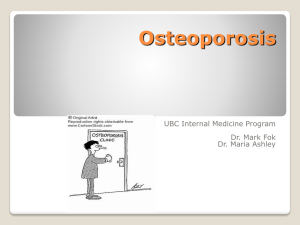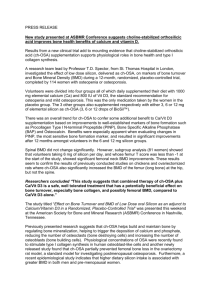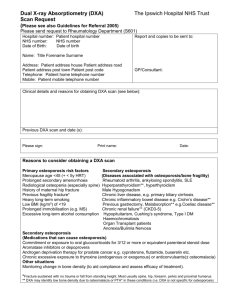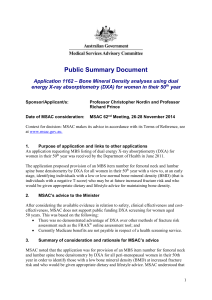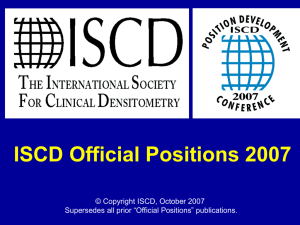Bone Mineral Density - Osteogenesis Imperfecta Foundation
advertisement
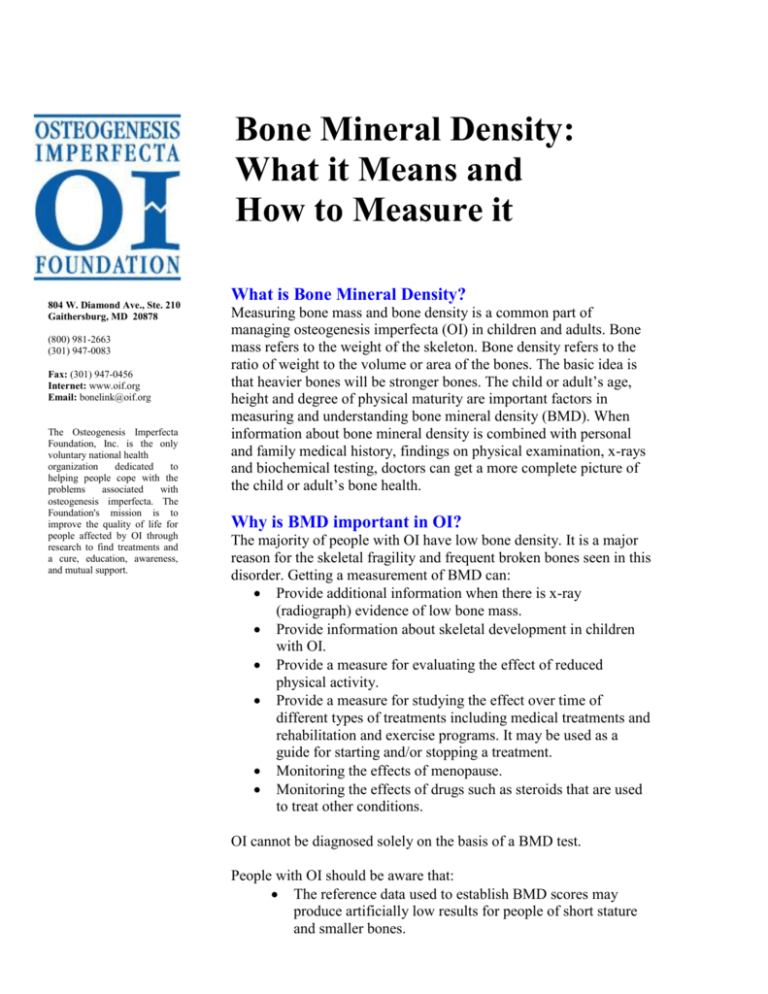
Bone Mineral Density: What it Means and How to Measure it 804 W. Diamond Ave., Ste. 210 Gaithersburg, MD 20878 (800) 981-2663 (301) 947-0083 Fax: (301) 947-0456 Internet: www.oif.org Email: bonelink@oif.org The Osteogenesis Imperfecta Foundation, Inc. is the only voluntary national health organization dedicated to helping people cope with the problems associated with osteogenesis imperfecta. The Foundation's mission is to improve the quality of life for people affected by OI through research to find treatments and a cure, education, awareness, and mutual support. What is Bone Mineral Density? Measuring bone mass and bone density is a common part of managing osteogenesis imperfecta (OI) in children and adults. Bone mass refers to the weight of the skeleton. Bone density refers to the ratio of weight to the volume or area of the bones. The basic idea is that heavier bones will be stronger bones. The child or adult’s age, height and degree of physical maturity are important factors in measuring and understanding bone mineral density (BMD). When information about bone mineral density is combined with personal and family medical history, findings on physical examination, x-rays and biochemical testing, doctors can get a more complete picture of the child or adult’s bone health. Why is BMD important in OI? The majority of people with OI have low bone density. It is a major reason for the skeletal fragility and frequent broken bones seen in this disorder. Getting a measurement of BMD can: Provide additional information when there is x-ray (radiograph) evidence of low bone mass. Provide information about skeletal development in children with OI. Provide a measure for evaluating the effect of reduced physical activity. Provide a measure for studying the effect over time of different types of treatments including medical treatments and rehabilitation and exercise programs. It may be used as a guide for starting and/or stopping a treatment. Monitoring the effects of menopause. Monitoring the effects of drugs such as steroids that are used to treat other conditions. OI cannot be diagnosed solely on the basis of a BMD test. People with OI should be aware that: The reference data used to establish BMD scores may produce artificially low results for people of short stature and smaller bones. An important and useful function of BMD scores is to be able to compare to oneself; looking for change over time. A BMD test is recommended before beginning a new treatment, so effectiveness can be evaluated over time. How is BMD measured? Bone densitometry measurements are often used to estimate fracture risk in people of all ages and as part of research studies. It uses a low dose of radiation in a simple and painless way to measure bone mass. Bone mass can be measured in the total body or in specific regions of the skeleton such as the spine; hips; legs and arms. These specific sites are chosen because they are easily accessible, or places likely to fracture. The amount of bone at each site is one of the factors that determine how much trauma or force it can withstand before it breaks. The most common method for measuring bone mass is called Dual Energy X-Ray Absorptiometry, or DXA. The DXA instrument does not enclose the person but does require holding still for approximately 60 seconds. To measure bone mass with a DXA machine, the person lies on a flat padded table and remains motionless while the “arm” of the instrument passes over the whole body or over selected areas. While the measurement is performed, a beam of low-dose x-rays from below the table passes through the area being measured. These x-rays are detected by a device in the instrument’s “arm.” The machine converts the information received by the detector into an image of the skeleton and analyzes the quantity of bone in the skeleton. The results are usually reported as BMD, or “bone mineral density,” the amount of bone per unit of skeletal area. Each measurement takes less than a minute to perform. For the spine measurement, the person’s lower legs rest on a Styrofoam cube with the hips flexed. For the hip measurement, the toes are placed in a “pigeon-toed” position to rotate the hips and provide the largest projected area to measure. For the arm measurement, the person sits on a chair beside the machine and places an arm into a holding device while the measurement is taken. For a total body measurement, which provides individual measurements of the legs, the trunk, the pelvis, the ribs, the arms and the skull, the person simply lies flat and motionless. Besides DXA, bone mineral density can also be measured using other types of equipment. Each uses different technologies to collect and measure information about bone health. Some of the machines include QCT – Quantitative Computed Tomography – used at the spine and other sites. pQCT – Peripheral Quantitative Computed Tomography – used at the wrist. How is BMD scored? What do Z-scores and T-scores mean? Results from a DXA are compared to two standards known as “age matched” or “young normal.” The Z score is age-matched and the T score compares to the young normal. For children the BMD is given as a Z score. It compares to the normal range for children of the same age. The Z score curves are very similar to growth chart curves. A Z score of 0 is similar to the middle line, a Z score of +2 is similar to the highest line and a 2 Z score of -2 is similar to the lowest line. Z scores do not take into account the child’s height or body size. This can lead to a false score for children with OI who are short for their age. One can compensate for this by comparing the child’s relative position on their height chart with the similar position in the BMD reference range. Scores for adults are given as T scores. The T score compares to a healthy 25-year old person of the same sex. A T score of 0 to -1 is considered normal, a T score of -1 to -2.5 is considered osteopenic and less than -2.5 is considered osteoporotic. It is important to remember that these scores compare to adults with normal or average height. T-scores may be artificially low for adults with OI who are shorter than average. What are some of the problems of DXA? Equipment made by different companies will not give identical scores. If possible, measurements should be performed on the same machine. Comparisons of measurements from different machines can lead to a false reading of an increase or decrease in BMD. Children and adults with small bones, and/or very low bone density may not get an accurate measurement because it is difficult to identify the outline of the bones. Skeletal deformities such as spinal curves or compression fractures, bowing in long bones and the presence of metal rods can significantly impair the results from a DXA. Body size has an important effect on DXA values and how they should be interpreted. DXA measurements in adults or children who are short for their age can be artificially low. It is important to be aware of the limitations of DXA use in OI Frequently Asked Questions Is densitometry safe? DXA technology is quite safe. Radiation exposure is exceedingly small, about the equivalent of playing outdoors all day on a summer day or flying across the United States in a jet plane. Using DEXA, a person receives less than 10 percent of the radiation received in a standard chest x-ray. State regulatory agencies permit routine measurement of healthy children. There is no needle stick involved, and one cannot feel anything when the x-rays pass through the body. Should babies have a DXA? Is anesthesia necessary? DXA can be helpful in babies with OI especially if they are starting treatment with bisphosphonates. There is a reference range of DXA values especially for babies. Normally the measurements are performed after the baby has fallen asleep and anesthesia is not necessary. How often should a person with OI have their BMD measured? Bone density measurements are usually performed no more than once a year in adults. Bone mass changes relatively slowly in most adults, even in people with OI. It is not useful to perform measurements when the expected changes in bone mass are smaller than the machine can accurately detect. Children are tested annually starting at age 5. It can be useful to test more often when a child is growing quickly. 3 For more information about osteogenesis imperfecta contact: Osteogenesis Imperfecta Foundation 804 W. Diamond Avenue, Suite 210, Gaithersburg, MD 20878 Tel: 800-981-2663 (free of charge) or 301-947-0083 Fax: 301-947-0456 Internet: www.oif.org E-mail: bonelink@oif.org This fact sheet was written by the Osteogenesis Imperfecta Foundation with assistance from Frank Rauch, MD and Moira Cheung, MD from the Shriners Hospital for Children -Canada The National Institutes of Health Osteoporosis and Related Bone Diseases ~ National Resource Center assisted in the preparation of this publication. Revised May 2007 4





